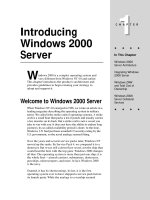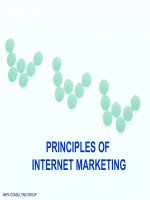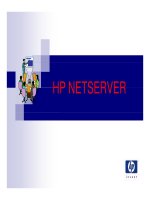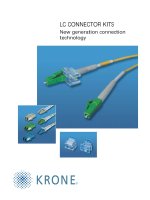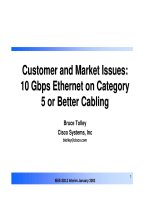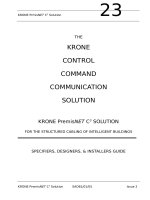Tài liệu Cisco CCNA1 Final Answered doc
Bạn đang xem bản rút gọn của tài liệu. Xem và tải ngay bản đầy đủ của tài liệu tại đây (460.8 KB, 22 trang )
www.ccna4u.org www.ccna4u.net www.ccna4u.info
1
1. Which OSI layer does IP rely on to determine whether packets have been lost and to
request retransmission?
application
presentation
session
transport
2. Refer to the exhibit. Which layered network model is shown in the diagram?
Cisco
IETF
OSI
TCP/IP
3. Refer to the exhibit. The diagram represents the process of sending e-mail between clients.
Which list correctly identifies the component or protocol used at each numbered stage of the
diagram?
1.MUA 2.MDA 3.MTA 4.SMTP 5.MTA 6.POP 7.MDA 8.MUA
www.ccna4u.org www.ccna4u.net www.ccna4u.info
2
1.MUA 2.POP 3.MDA 4.SMTP 5.MTA 6.MDA 7.SMTP 8.MUA
1.MUA 2.POP 3.SMTP 4.MDA 5.MTA 6.SMTP 7.POP 8.MUA
1.MUA 2.SMTP 3.MTA 4.SMTP 5.MTA 6.MDA 7.POP 8.MUA
4. A user enters in the address line of a browser. Which
statement is true about this transaction?
The "http" portion indicates the protocol that is being used.
The "web1.htm" portion is the specific service name.
The retrieved web page will be displayed in URL code.
The "www.cisco.com" is the name of the web page file that is called.
5. Which range of port numbers are reserved for services that are commonly used by
applications that run on servers?
0 to 255
0 to 1023
1024 to 49151
49152 to 65535
6. Which OSI layer addressing is required to route packets between two networks?
Layer 1
Layer 2
Layer 3
Layer 4
7. When connectionless protocols are implemented at the lower layers of the OSI model,
what is usually used to acknowledge that the data was received and to request the
retransmission of missing data?
IP
UDP
Ethernet
a connectionless acknowledgement
an upper-layer, connection-oriented protocol or service
8. Which statement is true about Layer 3 addresses?
They are physical addresses.
They are used in routing decisions.
They are only used on local networks.
www.ccna4u.org www.ccna4u.net www.ccna4u.info
3
They are altered each time a packet crosses a router.
9. Which option shows the PDU that contains the Layer 3 source and destination addressing for a
packet?
www.ccna4u.org www.ccna4u.net www.ccna4u.info
4
10. Refer to the exhibit. Host A sends 1000 bytes of Telnet data to host B. What does host B
send back if it only receives the first 500 bytes?
Source 23 Destination 49321 Seq 1000 Ack 500
Source 23 Destination 49321 Seq 500 Ack 1000
Source 23 Destination 49321 Seq 500 Ack 500
Source 23 Destination 49321 Seq 1000 Ack 501
Source 23 Destination 49321 Seq 501 Ack 1000
Source 23 Destination 49321 Seq 501 Ack 501
11. Refer to the exhibit. In a network, PC1 sends a message to PC2. The frame received at PC2 is
shown. What information in this frame determines the correct destination application?
timing and synchronization bits
destination and source physical addresses
destination and source logical network addresses
destination and source process numbers
12. What three statements are true about network layer addressing? (Choose three.)
Network layer addressing uses a hierarchy.
It uses addresses that are 48 bits in length.
It is used by Ethernet switches to make forwarding decisions.
It does not support broadcasts.
It uses a method by which the network portion of an address can be identified.
Network layer addressing identifies each host distinctly.
www.ccna4u.org www.ccna4u.net www.ccna4u.info
5
13. Which device should be used for enabling a host to communicate with another host on a
different network?
switch
hub
router
Host
14.
Refer to the exhibit. Host A attempts to establish a TCP/IP session with host C. During
this attempt, a frame was captured with the source MAC address 0050.7320.D632 and
the destination MAC address 0030.8517.44C4. The packet inside the captured frame
has an IP source address 192.168.7.5, and the destination IP address is
192.168.219.24. At which point in the network was this packet captured?
leaving host A
leaving ATL
leaving Dallas
leaving NYC
15.
www.ccna4u.org www.ccna4u.net www.ccna4u.info
6
Refer to the exhibit. When computer A sends a frame to computer D, what computers
receive the frame?
only computer D
only computer A and computer D
only computer B, computer C, and computer D
all computers
16.
What type of network is maintained if a server takes no dedicated role in the
network?
mainframe
client/server
peer-to-peer
centralized
17.
www.ccna4u.org www.ccna4u.net www.ccna4u.info
7
Refer to the exhibit. Assume all devices are using default configurations. How many
subnets are required to address the topology that is shown?
1
3
4
5
7
18.
Refer to the exhibit. Which type of network design is shown?
client/server
wide area
dedicated server
peer-to-peer
19.
www.ccna4u.org www.ccna4u.net www.ccna4u.info
8
Refer to the exhibit. Host A is accessing multiple servers. Which combination of port
number and address will uniquely identify a particular process running on a specific
server?
MAC address of the server and port number of the service
IP address of the host and port number of the service
MAC address of the host and port number of the service
IP address of the server and port number of the service
20.
A network technician is tasked with setting up a network for six users, but the users
should be able to use their accounts to log on from any of the six computers. What type
of network should be used?
workgroup
P2P applications
peer-to-peer network
client-server network
21.
What are three characteristics of CSMA/CD? (Choose three.)
Devices can be configured with a higher transmission priority.
A jam signal indicates that the collision has cleared and the media is not busy.
A device listens and waits until the media is not busy before transmitting.
